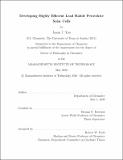Developing highly efficient lead halide perovskite solar cells
Author(s)
Yoo, Jason J.(Jason Jungwan)
Download1192966089-MIT.pdf (47.26Mb)
Other Contributors
Massachusetts Institute of Technology. Department of Chemistry.
Advisor
Moungi G. Bawendi.
Terms of use
Metadata
Show full item recordAbstract
Lead halide perovskite solar cells are an emerging technology that can be solution processed to yield low-cost, light weight and flexible photovoltaics. Much of the early work has been focused on developing device structures and processing techniques to improve light absorption and eliminate detrimental traps within the bulk of the perovskite active layer. As a result, the device efficiency of perovskite solar cells has improved from ~3% up to ~20% in less than a decade. However, the device efficiency of perovskite solar cells still need to be much improved in order to compete with traditional photovoltaic technologies, such as Silicon and GaAs, and to ultimately realize the theoretically determined Shockley-Queisser (SQ) efficiency limit. In this thesis, I focus on the development of a novel interface passivation strategy called selective precursor dissolution (SPD) strategy, that utilizes low dimensional 2D perovskites as the interface passivating layer. The post treatment of the bulk perovskite thin film with 2D perovskites via SPD strategy prevented formation of a detrimental non-perovskite phase at the interface and resulted in much improved thin film quality with reduced detrimental interface recombination. As a result, a certified power conversion efficiency (PCE) of 22.6% is achieved from a quasi steady-state measurement along with an electroluminescence (EL) efficiency up to ~9%. Both device metrics were the highest values reported at the time of publication. In addition to developing an interface passivation strategy to improve device performance, a high quality electron transport layer (ETL) was developed and a new perovskite composition was adopted to further improve the device performance. A chemical bath deposition (CBD) was used for the synthesis of a tin dioxide (SnO₂) ETL. The pH of the reaction solution is identified as the key parameter for the CBD of SnO₂ that controls the quality of the SnO₂ ETL. pH 1.5 is determined to be the optimum acidity that results in a SnO₂ ETL with compact and conformal coverage without producing a detrimental secondary crystal phase. To improve the optoelectronic properties of the perovskite active layer, MAPbBr₃ is significantly reduced to minimize the band gap penalty, which also resulted in improved effective carrier mobility. MAPbBr₃ is commonly added to the perovskite composition to stabilize the [alpha]-phase FAPbI₃ but results in an increase in the band gap. Addition of 0.8 mol% of MAPbBr₃ to the FAPbI₃ perovskite resulted in much improved carrier lifetime and effective mobility, compared to conventionally added 10 mol%. Together with the new SnO₂ and the perovskite active layer, a record setting and certified PCE of 25.2% is achieved, which translates to 80.5% of the SQ limit for its band gap. In addition, due to low open-circuit voltage (V[subscript OC]) loss, the newly developed devices exhibit an EL efficiency up to 17.2% and an EL wall-plug efficiency up to 21.6%. Both PCE and the EL efficiency is the highest reported so far from a single perovskite solar cell structure.
Description
Thesis: Ph. D., Massachusetts Institute of Technology, Department of Chemistry, May, 2020 Cataloged from the official PDF of thesis. Page 132 blank. Includes bibliographical references (pages 119-130).
Date issued
2020Department
Massachusetts Institute of Technology. Department of ChemistryPublisher
Massachusetts Institute of Technology
Keywords
Chemistry.